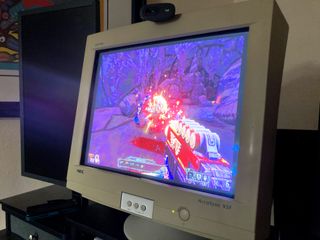
After budgeting out the next tier of upgrades for my PC, the total cost of my new components had me endlessly second-guessing every dollar. I kept thinking "do I really need this?" and "how much of a difference will this really make?", the answer to both always being some weaselly variation of "it depends." Now more than ever, it feels like having top shelf hardware means little in the world of unoptimized, unfinished triple-A games, and crossing the rubicon of 4K gaming is flat out impossible if you can't drop $1,000 on a graphics card alone.
So I went in the opposite direction. I bought a CRT, instead.
If you've done a cursory search on what modern gaming on a CRT looks like in the 2020s, you might have come across this deep dive by Digital Foundry. It's a great video, and outlines some of the technical benefits of a CRT display—vibrant, vivid colors that truly pop, with deep blacks and blinding whites that LCDs can only dream of. A responsiveness and motion clarity still unmatched today by most hi-refresh flatscreens. That Digital Foundry video shows off the Sony FW900, the Rolls Royce of CRT displays, capable of handling 4K resolution at 16:10.
You and I will likely never find a monitor that good without a Craigslist miracle, as they are exceedingly rare and ludicrously expensive. No, if you walk down this path, you will most likely be settling on something in the 900p range at 4:3, specs that don't necessarily dazzle on paper. But the experience of using a CRT to play PC games, especially fast-paced shooters, is so much better than the specs can convey—you'll feel like Milhouse playing Bonestorm.
Bunny-hopping from one shootout to another in Dusk felt nearly as good as it looked, with the contrasting saturated and desaturated extremes of its art design exploding with rich tones and deep shadows. The same went for grimdark counterparts Warhammer 40,000 Boltgun & Darktide—where Boltgun's blues and magentas were overpowering, the depth of the browns, blacks, and greens in Darktide had the picture looking like it had been doused in industrial grime. Hotline Miami's pulsing backgrounds were like tsunamis of liquid neon pouring out of the screen.
Even getting one of these things is a hurdle, though. Because of their size and age, it makes the most sense to buy and pick up locally, which means poking around for a community in your area. When I decided I wanted to hunt down an old monitor, I joined a local vintage computer parts group and asked an admin for some tips on where to start looking for a 19-inch CRT. I totally lucked out when he said he had one he was about to list for $80.
If you're looking to bag one for yourself, it's worth keeping an eye on those big e-waste recycling bins you see at the local mall every now and again—you may not even have to spend any cash. Facebook marketplace & Kijiji listings are great spots too, especially when you search with the keywords "old computer monitor."
Comic deals, prizes and latest news
Sign up to get the best content of the week, and great gaming deals, as picked by the editors.
One fumble I made during my acquisition was not pre-measuring the full footprint of the monitor—a CRT is going to be fighting your entire setup for the space it deserves, ideally a deep corner desk with plenty of support. My motorized standing desk has been begging for death since I got this thing in January.
When I had finally set everything up (and properly configured the RGB balance), I basked in the full glory of yesteryear's technology, the CRT filter options in Hotline Miami and emulators immediately made redundant. One of the first games I rushed to boot up was Armored Core 3 (emulated through PCSX2), a long overdue replay in advance of the upcoming Armored Core 6. The CRT melted away a lot of the jagged low-res "details" mapped onto the exposed surfaces of the mecha, now giving more of an impression of rivets, sensors, and panels rather than the masses of pixels actually conveying them.
CRT displays are coveted in the retro gaming community, particularly among fighting game fans who treasure the few extra frames of responsiveness an analog signal grants them. Low res console games also benefit visually by sidestepping the muddying process of HD upscaling. The CRTPixels account on Twitter highlights how the "fuzz" of a CRT display smoothes out the naturally rough edges of pixel art (often for the better), and modern games benefit from that analog fuzz too, giving the image a sort of built-in anti-aliasing.

On high-end PC games, this frees up significant GPU muscle that can be directed towards texture quality, lighting, or resolution—running the notoriously unoptimized Darktide at 1050p with most of the post-processing disabled produced a noticeably more appealing image on a CRT than on my LCD monitors, and giving me a few extra much-needed frames. I had the same experience with Cyberpunk 2077—soaking in the iridescent electric blues, greens, and magentas of Night City was so transformative I wound up replaying the whole game over the course of a week.
Not only were the intensely vibrant color palettes of Night City's distinctive districts made eye-wateringly beautiful on an analog display, but my calculated drop in graphical settings had performance consistent throughout.
There are, of course, very significant drawbacks and compromises. I decided to test latency by playing through the back half of the marvelous Bayoneta 1 PC port and was bombarded with impossible-to-dodge off-screen attacks. The screen responsiveness was great, but the game logic doesn't account for your aspect ratio when determining the aggressiveness of enemy AI, an unexpected example of software incompatibility. If you're eco-conscious or subject to a pricey power bill already, you also have the garish power draw to keep in mind.



But there's a real charm underneath all the hassle that's earned this beast a place in my setup. Powering up my CRT feels heavy and deliberate, like I'm firing up the engines of the Nostromo. The power button sinks deep into the chassis, like the priming agent for an electro-chemical palantir encased in yellowed, cigarette stained plastic. When the screen comes to life, it's a slow trickle of brownish greens and blues slowly finding the right hues, blossoming into this vibrant, iridescent fuzz. An ear-piercing discharge of electrons drops to a low whine, a constant reminder that there's something moving behind the glass. It's easy to see why these things are now so fetishized when it's right in front of you—it feels like magic.
CRTs are too few and far between to be the first choice for those who want to be on the cutting edge of high refresh, high resolution displays, but for the hobbyist with a budget build and open mind, I think it's seriously worth considering one. The revitalized experiences with some of PC gaming's least cooperative recent releases was an unexpected benefit of modern gaming on a CRT, and part of why I think it's worth picking one up if the stars align and you can get a working one at a decent price. My monitor found its niche as a dedicated emulation and retro FPS display, occasionally running the odd pixel art indie game or Media Player Classic.
Ultimately, I loved having something that concretely anchored me to the history of PC gaming that, like building my own PC, requires its own level of tuning and finesse to get the most out of.

Noa Smith is a freelance writer based out of Alberta, Canada. Noa's grab bag of non-gaming interests and passions includes Japanese mecha anime, miniature painting, as well as history, literature, and classical music. Noa also moonlights as a bureaucrat and amateur historian.
Most Popular



